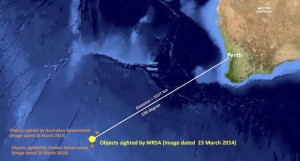Undersea volcanoes, huge seas complicate search for plane debris

This graphic released by the Malaysian Remote Sensing Agency on Wednesday, March 26, 2014, shows the approximate position of objects seen floating in the southern Indian Ocean in the search zone for the missing Malaysia Airlines flight MH370. Searchers racing to find the plane’s black box face daunting hurdles ranging from undersea volcanoes to mountainous seas as they operate in one of Earth’s most remote locations, experts said on Wednesday. AP
SYDNEY—Searchers racing to find Flight MH370’s black box face daunting hurdles ranging from undersea volcanoes to mountainous seas as they operate in one of Earth’s most remote locations, experts said on Wednesday.
They warned there was no guarantee that an unprecedented international search operation involving the militaries of six nations would succeed in retrieving wreckage of the doomed Malaysian Airlines plane that disappeared on March 8 with 239 people on board.
‘Roaring Forties’
University of New South Wales oceanographer Erik van Sebille said the crash site was in an area known as “the Roaring Forties,” notorious among mariners for its hostile seas.
“In general, this is the windiest and waviest part of the ocean,” he said. “In winter, if a storm passes by you can expect waves of 10-15 meters.”
The Soufan Group, a US-based strategic security intelligence consultancy, likened searching for debris in such conditions to “finding a drifting needle in a chaotic, color-changing, perception-shifting, motion-sickness-inducing haystack.”
“A random wave might obscure the object when the eyes pass over it; sun glare off the water may blind momentarily; a look 2 degrees to the left when the object is most visible may cause the moment to pass,” it said.
Volcanoes extremely active
Even if the search does find verifiable wreckage from MH370 on the surface, geologist Robin Beaman said underwater volcanoes would probably hamper efforts to recover the black box flight recorder from the depths.
Beaman said the Southeast Indian Ocean Ridge cut directly through the search area, meaning the seabed was rugged and constantly being reshaped by magma flows.
He said the ridge was an “extremely active” range of volcanoes sitting at an average depth of 3,000 meters, which marked the point where the Antarctic and Australasian tectonic plates collide.
“It’s very unfortunate if that debris has landed on the active crest area, it will make life more challenging,” Beaman, who specializes in underwater geology at Queensland’s James Cook University, told Agence France-Presse.
“It’s rugged, it’s covered in faults, fine-scale gullies and ridges, there isn’t a lot of sediment blanketing that part of the world because it’s fresh (in geological terms),” he said.
What happened?
Finding the flight and cockpit voice data recorders will be crucial in determining what caused the Boeing 777 to deviate inexplicably off course and fly thousands of kilometers in the wrong direction.
Malaysia believes the plane was deliberately diverted by someone on board.
University of Sydney aviation expert Peter Gibbens said searchers faced a race against time, with acoustic signals from the black box set to fall silent in about two weeks when its battery expires.
“They’re going to be pushing it with time, the chances are stacked against them,” he said.
Virtually pristine
In a sign of the level of cooperation achieved in the search, the US military has sent a hi-tech black box locator to Perth, which will be fitted to an Australian Navy ship so it can scour the likely crash site.
Van Sebille said the remote location at least meant searchers did not have to contend with the large collections of random garbage that litter most other oceans, reducing the likelihood they would be distracted by false leads.
“This area of ocean is virtually pristine,” he said, explaining that ocean currents in the area naturally moved flotsam north, away from the search area.
He said this meant the large objects that had been sighted by air crews were likely to have come from MH370.
“If the plane would have gone down in any of the other ocean basins I would be much more skeptical that the pieces of debris spotted were actually part of the plane,” he said.
RELATED STORY